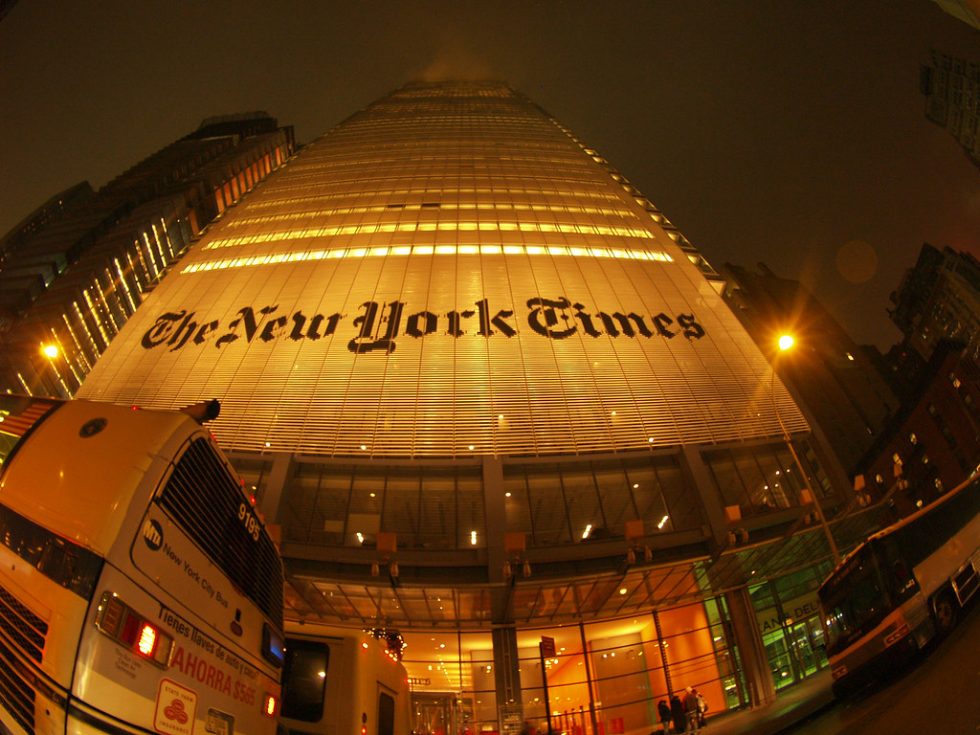
Cover image: Flickr.
How does a newspaper not just survive but thrive in the midst of a crisis that has been shaking journalism for years? To find out, I spoke to Valerio Poce, executive director of ad product marketing at the New York Times.
Poce discussed the cultural surprises of moving from tech to media, how a 170-year-old institution continues to reinvent itself, and the unexpected ways technology is reshaping everything from the way we read the news to sharing a recipe with friends.
He also explained how the paper is confronting the broader crisis facing journalism by diversifying well beyond news — into games, cooking, product reviews and more.
In this conversation, he reflects on what it means to work at a company where tradition and innovation constantly collide, and why, at its core, the New York Times remains a “fundamentally human endeavour” – even as it embraces machine learning and experiments with AI.

Valerio Poce, executive director of ad product marketing at the New York Times.
You moved from tech to media — on the surface, a major leap. What were the biggest cultural or operational differences you noticed when joining the New York Times?
It’s not as big a shift as it may seem from the outside. My role as product marketing leader overseeing digital advertising products has remained consistent, and the Times offers the same kind of advertising solutions as tech platforms, but in a different context. Operationally, at least within the parts of the company focused on building and marketing products, we have many of the same teams and processes that you’d find in a tech company.
Something must have changed – moving from big tech to one of the world’s most respected news organisations is not a minor shift.
The biggest shift for me was moving from relatively young companies – when I joined Google and then Meta, they were 14 and 16 years old respectively – to the Times, which has an incredibly long and rich history. Its mission has remained both true and relevant across decades. Our core value of upholding the independence of our journalism shapes most of the decisions I make each day, even though I don’t work in the newsroom.

Photo: Unsplash.
The New York Times has increasingly positioned itself as a tech-media hybrid. In your view, what does it truly mean to be a tech-media company in 2025?
The Times has made incredible strides in evolving as a technology-driven organisation, starting shortly before I joined the company. To thrive today, media companies have to meet people’s consumption preferences and expectations – which are now almost entirely digital, visual, accessible and communal. The Times now has a portfolio of digital offerings that, with news at the centre, extends well beyond it: Games, Cooking, Wirecutter, and The Athletic. All of our coverage is increasingly delivered via video – one in three homepage visitors last year watched a video – and is designed to be engaging. Games recently launched a feature that lets you challenge friends, and the comment section in New York Times Cooking is one of the most wholesome places on the internet.
In an age of vertical information, how do these sections help attract niche audiences and advertisers seeking more engaged readers?
As our scale continues to grow — 11.7 million subscribers and nearly 100 million weekly visitors — we offer brands increasingly sophisticated ways to reach and engage with our valuable readership. This applies to ad placements – Games is a prime spot for vertical video advertising –, to formats, with the introduction of shoppable ads, and to ad targeting, including models that predict a reader’s propensity to take action and new approaches like Data Clean Rooms. Thanks to this technical evolution, the Times is now a publisher that plays like a tech platform, in the sense that we can offer the kind of scale and the types of products that were, until recently, the exclusive domain of the tech platforms.

The New York Times headquarters at 620 Eighth Avenue, Manhattan, New York City. Photo: Wikimedia Commons.
The shift from a traffic-based, ad-funded model to a paywall-driven strategy was a major turning point. What were the biggest challenges in making that transition – and what comes next for your subscription model?
When we first launched our subscription strategy, we were competing in a media market dominated by free journalism and content, and many in the industry doubted we would succeed. But the New York Times made a bet on creating journalism worth paying for, and we’ve seen growth and engagement ever since. Our subscription business has become a competitive advantage for our advertising business, and the two complement each other well. The Times offers a subscriber experience that is worth paying for, while our advertising team delivers ads that are compelling and high quality – and therefore perform well. Both our consumer and advertising experiences operate to the same high standard, with a focus on quality and a premium feel. In fact, advertising continues to be a significant contributor to The New York Times Company.
And will it remain central going forward?
Yes, we’re excited about what’s ahead for advertising, as we continue expanding opportunities across the entire Times portfolio. There are so many valuable and distinctive placements we’re unlocking for advertisers, and that will remain a key focus of our strategy.
Artificial intelligence is another game changer for newsrooms. How is the New York Times currently applying AI in its editorial operations?
While I’m not in the newsroom, as a company we’ve long adopted AI and machine learning to grow our audience, drive engagement, personalise experiences across our portfolio, and create a more dynamic paywall. The Times is experimenting on several fronts to advance both our journalism and our products – from making coverage more accessible, such as through articles read by automated voice, to improving how we work, including exploring workflow enhancements across the organisation. Most importantly, our journalism – along with recipes, games, product reviews and sports coverage – is a fundamentally human endeavour. Our guiding ethos in adopting AI technologies is to strengthen the work our people are already doing.

The New York Times has signed a deal with Amazon to license its editorial content for use across the company’s artificial intelligence platforms. Photo: Canva.
Let’s return to advertising for a moment. How is AI shaping ad personalisation and brand matching at the New York Times? Have you seen meaningful improvements in performance or targeting?
We’re no strangers to embracing new technologies to evolve our advertising solutions. In fact, we’ve been using machine learning models to power our targeting since 2018. So when generative AI emerged, it was natural for us to explore how it could take things further. We’ve found a powerful solution in a targeting method we call BrandMatch, which builds a custom audience segment for every campaign. It uses generative AI to analyse the marketing brief, identify relevant content across the Times’s coverage, and target the readers most engaged with that content. It’s a sophisticated yet operationally simple process that enables each brand to reach the people most likely to be interested in their campaign.
What results has BrandMatch delivered so far?
Since launching in September 2024, we’ve used this targeting method across hundreds of campaigns, and the performance has been impressive. Click-through rates are nearly twice as high as the average for other targeting methods, and brand lift has remained consistently strong, particularly in the mid-funnel stages: consideration, intent and preference.

Photo: Unsplash.
Do you have any specific predictions about how the advertising model for news organisations like the New York Times will evolve over the next decade?
It’s hard to make precise predictions, given how dynamic the media and advertising landscape has been lately, but there are a couple of important things I’d highlight from my position in advertising. First, it will become increasingly important to nurture a direct relationship with readers. Thanks to our investment in journalism and our subscription strategy, millions of people come to the Times directly. This not only safeguards our traffic — it also enables a more direct connection between advertisers and readers. Second, media organisations will succeed if they help brands break through the noise of internet slop and passive engagement, and instead capture meaningful, active attention. Times readers are not only curious — they’re deeply engaged with our content, and we’ll continue to deliver on that value.








